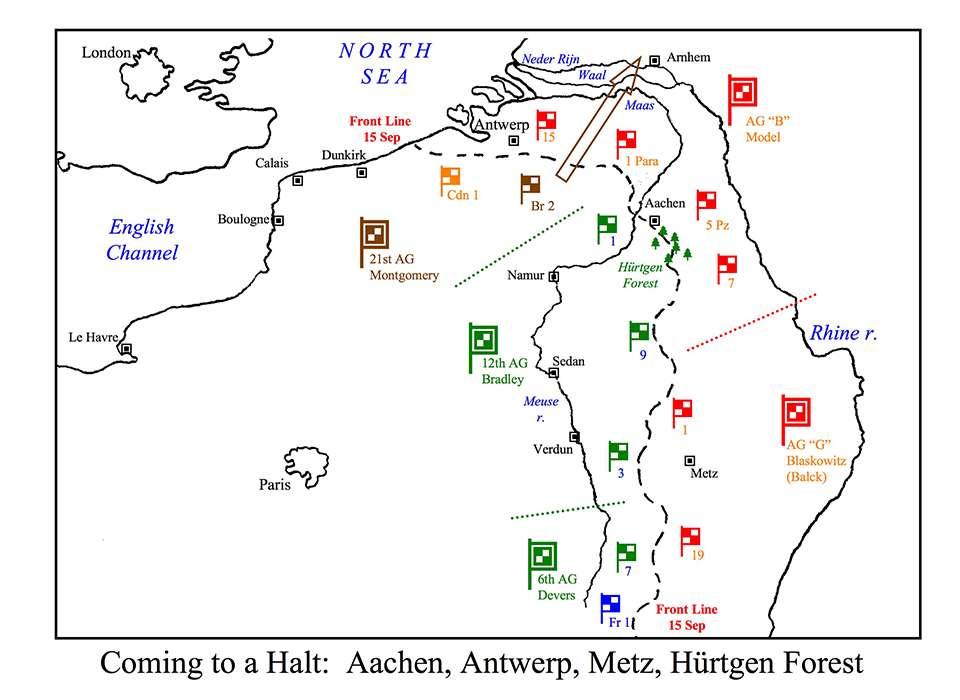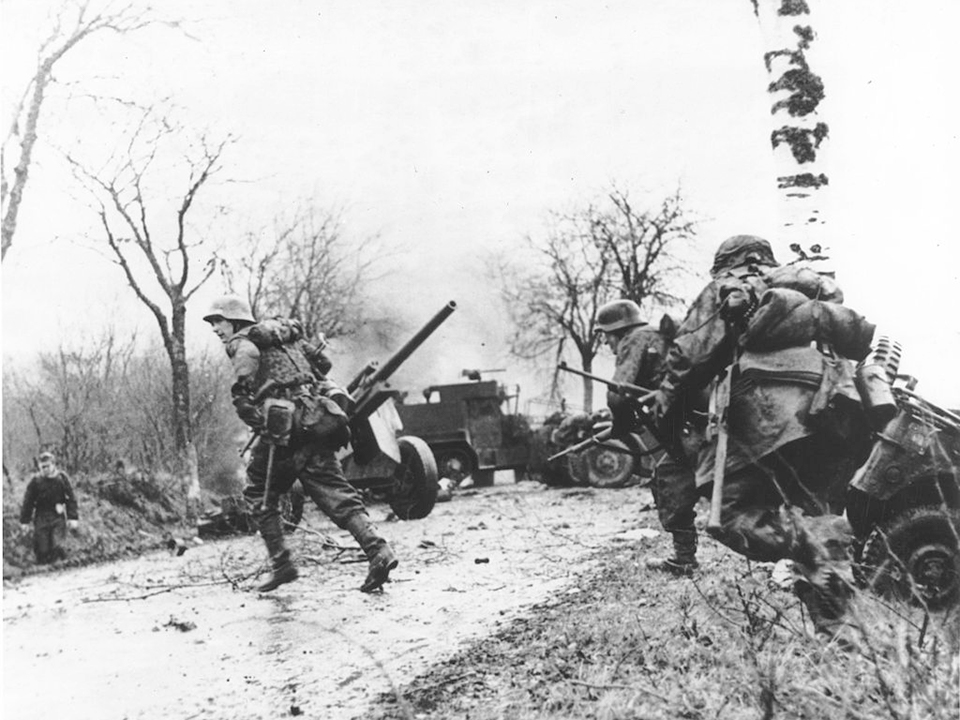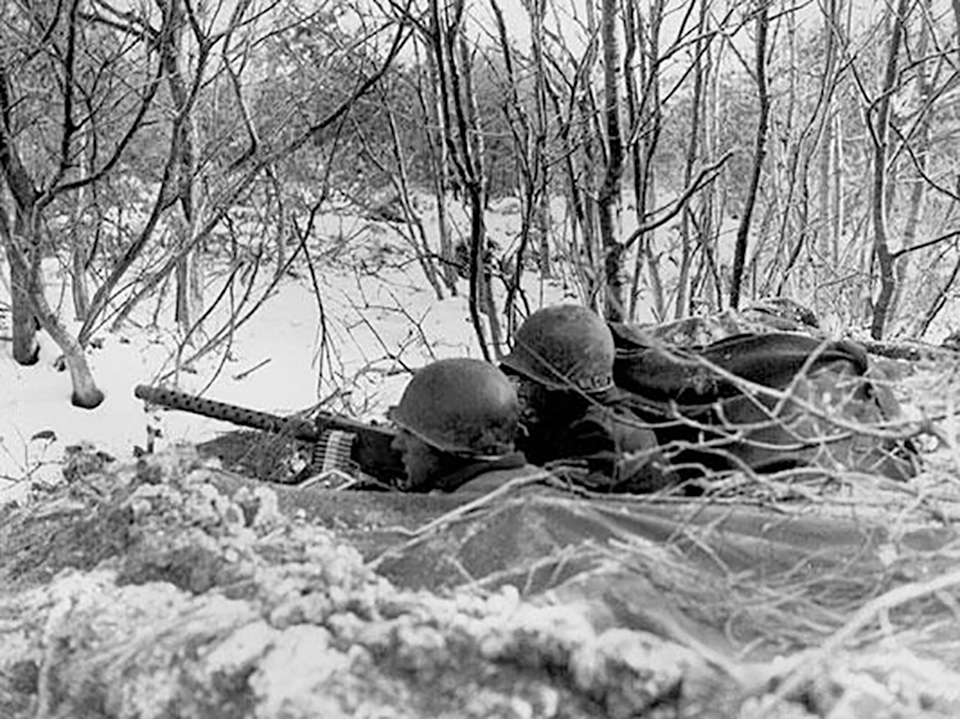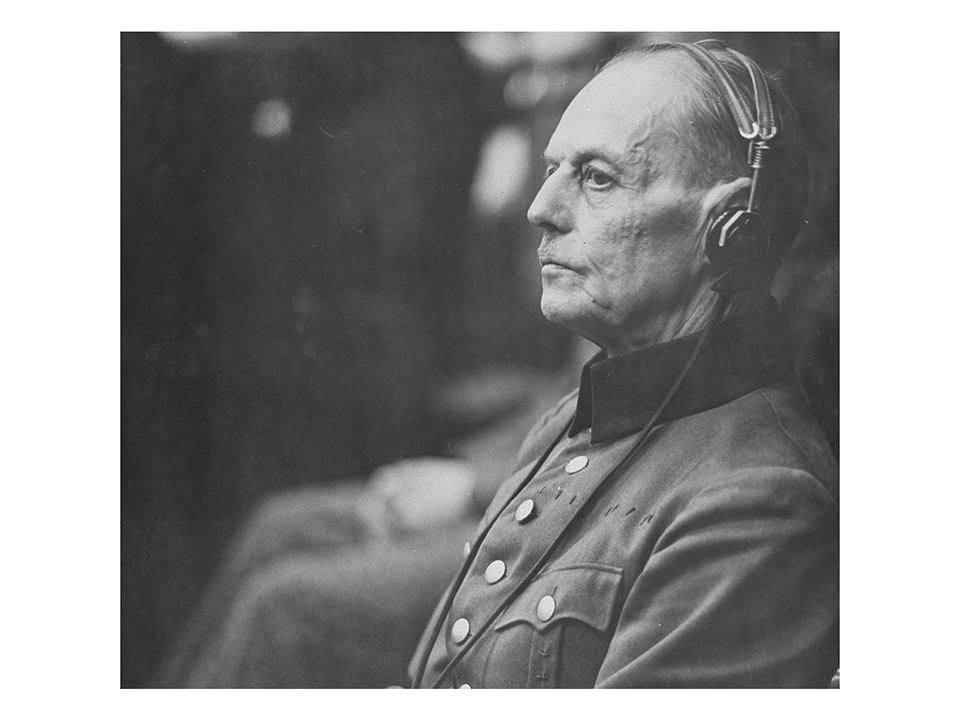The first German shells came as a jolt. It was 0530 on a wintry Saturday morning, December 16, 1944. American troops atop the ridge known as the Schnee Eifel weren't expecting much action that morning. In fact, the 106th Infantry Division had just gotten to the front a few days before, relieving the 2nd Infantry Division in the Ardennes Forest, a sector of the front so quiet and uneventful that the GIs had started calling it the "Ghost Front." It was a perfect place for a green unit to get acclimated to the rigors of life in the field and to the routine of front-line duty. By World War II standards, it was almost idyllic.
But now, as the Germans suddenly opened up with everything from nimble 3-inch mortars to massive 16-inch railway guns, the Ghost Front didn't seem quite so peaceful. The "battle of the Bulge" had begun. The men of the 106th–the "Golden Lions," they were called—didn’t know it, but they were about to plunge into one of the worst disasters in US military history. Within days, their division would be destroyed, and most of them would be spending the rest of the war in German POW cages.
After the end of the war in 1945, a false impression of the fighting in Europe emerged, one that viewed the campaign as a kind of triumphal Allied parade from the beaches of Normandy to the Rhine, and then over the river and into Germany. It was one victory after other, in other words, the inevitable triumph of a better equipped and more powerful Allied force. But in war, even the winning side usually has its share of catastrophes. What happened to the officers and men of the 106th should change the way we think about the end of the war in Europe. Even in the context of overall victory, life or death was always hanging by a thread.
Caught by surprise, the men of the 106th did what soldiers in such a predicament have done from time immemorial. Depending on their precise location and post at the moment, they tumbled out of bed, or they ran into each other in their haste, or they desperately tried to get the ice-cold engines in their jeeps to turn over, or they fired wildly in every direction. Their officers—from the divisional commander, Major General Alan W. Jones, on down—never did get their troops in hand or under control, and the result was a complete lack of cohesion and fighting power. Much of the division tried to run. Writing in 1949, the division's official historian, Colonel R. Ernest DuPuy, used an ugly word to describe what happened: panic.
Let's get down to hard facts. Panic, sheer unreasoning panic, flamed that road all day and into the night [of 16 December 1944]. Everyone, it seemed who had any excuse and many who had none, were going west that day.
The Germans never assaulted the positions of the 106th directly. Rather, their plan in this sector of Operation "Watch on the Rhine," the great counteroffensive in the Ardennes and the last real gasp of Adolf Hitler's Wehrmacht, called for one column to assault through the relatively open terrain of the Losheim Gap to the north of the Schnee Eifel, while a second, complementary column punched through US lines to the south of it. The rapid link up of these two pincers behind the Eifel encircled two entire US infantry regiments of the 106th Division, the 422nd (Colonel George L. Descheneaux, Jr.) and the 423rd (Colonel Charles C. Cavender), perhaps 7,000 men in all. They were now surrounded, out of contact with neighboring units, and cut off from supply. They would surrender, en masse and on the orders of their regimental commanders, on Tuesday, December 19th, day four of the German operation. It was "the most serious reverse suffered by American arms" in the entire European campaign.
The "what" was bad enough, but getting at the "why" has been more difficult. Much of the focus, understandably, has been on the division itself. Since their activation in March 1943, the Golden Lions had been training soldiers and then, as American casualties began to mount in Europe, losing them to the replacement pool. Indeed, in the course of 1944 alone, the division had to give up over 7,000 men, about 60% of its allotted strength. In their place came a diverse parade of human material: 1,100 air cadets, 1,500 from other divisions still stationed in the United States, 2,500 from various disbanded units, and men combed out of the supply and quartermaster services. The rush of events threw them all together hastily, and some of them were still in-processing mere weeks before the division itself departed for Europe, hardly a recipe for unit bonding or cohesion under fire.
The 106th, in other words, was very much an assembly-line division, a pack of raw draftees thrown together with a handful of experienced officers and NCOs. It had no real tradition, either old Regular Army or National Guard. It could not forge ahead into battle crying, "Rock of the Marne!" (like the 3rd Infantry Division) or "Texas!" (like the 36th). It had to be content with a "pre-fabricated tradition" that probably didn't go beyond loyalty to your buddy or to the man in the next foxhole.
All these negative factors have seemed damning to later historians. Speaking of the men the division had to give up, Dupuy would later write:
[M]any men who had developed early, who first had shown an aptitude, who were already of the grade of private first class, or higher, were the men chosen to be removed from the Division before it ever left the states.
Colonel Ernest Dupuy
As to the new levies, Dupuy wrote, "one cannot say that these men were of inferior quality. One can say that one doesn't take more than fifty percent of a trained unit's complement away, fill it with other men, and expect it to enter battle as a combat team."
Dupuy's argument was fair and judicious, to be sure. The only thing wrong with it was that dozens of other US Army divisions went through the exact same process as the 106th: lack of distinct identify, cookie-cutter training and equipment, hasty origins, manpower treated as an interchangeable commodity rather than as a precious resource. This was the way that the Army did business in World War II--perhaps the way it still does business today. Very few US Army infantry divisions ever developed an enduring historical personality. The 1st, with its "Big Red One" insignia, was the exception that proved the rule. Nevertheless, the wartime performance of these divisions proved, by and large, that the Army had a method to its madness. Many divisions, just as anonymous and interchangeable, went overseas and covered themselves with competence, and some even with glory.
By contrast with the 106th, other American units involved in the Schnee Eifel fight had characteristics that should have given them an advantage. Take the unit protecting the division's northern flank, the 14th Mechanized Cavalry Group (MCG) under Colonel Mark Devine. An MCG was a high-mobility, high-firepower regimental-sized formation designed for holding the flanks of a division, corps, or army. They had high levels of aggression and a tight esprit de corps based on the Army's longstanding and heroic cavalry tradition.
Unfortunately, the 14th didn't do much better than the 106th Division in the opening phases of the Ardennes fighting. Assigned the Losheim Gap as its group sector, it functioned as little more than a speed bump for the onrushing Germans, compromising (fatally, as it turned out) the security of the entire division to its south. The reasons were legion: the relatively open terrain associated with the geographical term "gap"; a huge assigned frontage; the overwhelming nature of the German assault. Devine had only two squadrons (battalions, in infantry parlance), placing one up front (the 18th), and the other (the 32nd) in reserve, some twenty miles behind the line at Vielsalm. His frontage was 9,000 yards, or over five miles. This was nearly the frontage for an entire infantry division, and covering it in any meaningful sense was probably impossible.
Devine gave it a shot, however, dispersing the 18th Squadron into a number of isolated and immobile strongpoints. The static deployment negated the real strength of an MCG, its mobility, however, and ran contrary to the doctrine and training of mechanized cavalry. Given the relationship between his frontage and his combat power, he probably made the only decision he could. Nevertheless, the outcome was predictable. The Germans overran the strongpoints they chose, and the garrisons of the others had no choice but to pull back. As a result, the Germans penetrated the Losheim Gap within 48 hours, and the 14th MCG’s defense barely deserved the title of delaying action.
Likewise, the division on the opposite flank of the 106th, the 28th, was one with a long tradition and history, just the sort of things that the 106th is supposed to have lacked. The 28th was once a Pennsylvania National Guard unit and was still proud of its distinctive keystone insignia (and indeed, called itself the “Keystone Division”). The Germans had met it in battle before and respected its abilities, dubbing it the "Bloody Bucket division," and its commander was one of the real heroes of the Normandy landing, General Norm "Dutch" Cota. It had fought its way through the hell of the Hürtgen Forest and was now in the Ardennes resting, recuperating, and incorporating replacements. But even this veteran division had its problems in the opening days of the battle of the Bulge, with German spearheads penetrating it in numerous places and cutting it off from contact with the 106th Division to the north. While most of Cota's division managed to hold its position, the early fighting had decimated it and left it shaken.
Finally, any blanket condemnation of the 106th Division's fitness for battlefield duty must reckon with the denouement of the Schnee Eifel fight. The division's third regiment (the 424th under Colonel Alexander D. Reid) opened the battle deployed several miles back from the front and had therefore escaped the fate of its brother regiments. It would manage to retreat across the Our River and give a decent accounting of itself in the fight for the crucial road junction of St. Vith. Based on the evidence in this case, at least, the manpower of the 106th did not seem to be the reason for the failure in the Ardennes.
If it wasn't the fault of the rank and file, then what of the division's leadership? General Jones, many historians have been quick to point out, had never been in action before, and neither had his regimental commanders. All of them seemed bewildered by the sudden avalanche of events, and none of them had a ready-made solution to hand. The firmest moment of the entire four-day sequence for Colonels Descheneaux and Cavender, the one real stamp they put on the battle, was their decision to surrender their regiments. Still, the fact that none of them had heard a shot fired in anger up to this point in the war didn't guarantee failure. There were a great number of US Army officers in World War II about whom one could say the same thing, General Dwight D. Eisenhower among them. Once again, lack of combat experience could not have been a sufficient cause of the disaster.
Another command factor might have been more relevant. Jones was probably ill with angina before the battle even started. The stress of the opening days, the collapse on his flanks, and the encirclement of his division's main body overwhelmed him, and he suffered a heart attack on the night of December 22-23, day seven of the battle. A general felled in the heat of battle can certainly have a detrimental impact on divisional performance, and perhaps Jones's ill health was part of the reason for the 106th's travails.
But was it really a heart attack? Historian Charles Whiting, a leading authority on the Bulge, has speculated in print that the heart attack may well have been a "polite fiction" or "propaganda measure," a public relations gesture designed to cover up the general's (and by extension, the institutional army's) battlefield failure. Even Whiting wound up striking a sympathetic note, however. "Perhaps it is not politic to inquire any further," he wrote. Whether stress or nervous collapse or simply the bitter realization that he had failed as a commander, General Jones was "a casualty of the battle just as surely as if he had been struck by a bullet." That is to say, his collapse might have been the result, but almost certainly was not the cause, of the defeat.
Indeed, perhaps the real problem did not lie with the division at all, but rather emerged from a series of factors beyond Jones' control, or that of the Golden Lions in general. Consider the operational situation at the time. The Allies had smashed the German armies in Normandy back in August, a triumphant campaign that culminated in the Falaise Pocket. Happy notions that the Germans were finished soon came to grief, however. The daring plan of General Bernard Law Montgomery to cross the Rhine on an airborne carpet aimed at Arnhem in the Netherlands (Operation Market Garden) failed. The US Army did little better. Hard fighting at Aachen (the first German city conquered by Allied arms), in the Hürtgen Forest, and finally in Lorraine showed the Americans that there was still a great deal of fight left in the Wehrmacht. In all these battles, Allied supply problems were beginning to affect fighting strength at the forward edge, and in fact logistics probably took up the majority of Eisenhower's working hours.
For all these reasons, the Allied force that reached the German border in December was utterly fought out and in a certain sense demoralized. What had looked like a lightning thrust to victory had stalled in front of the main German defenses in the west, the Siegfried Line: barbed wire, concrete pillboxes and bunkers, "dragon's teeth" tank traps, and more. After the high hopes of August, it was a depressing moment for the Allies; and of course, to make things even worse, this was the precise moment that the Wehrmacht chose to launch its last great offensive of the war, aimed at US forces in the Ardennes sector.
To Hitler, the operation would revisit the site of his greatest victory, the destruction of the French army in 1940. The Panzers would smash though the weak US line, pass through the Ardennes, cross the Meuse river and reach the great port of Antwerp. With US forces mauled and the Allies cut off from their main supply port, he believed that the western alliance might even unravel. By this point in the war, he was going for broke, stripping replacements and supplies from the rest of his hard-pressed fronts and assembling three complete German armies for the assault: the 6th Panzer Army (under SS General Josef "Sepp" Dietrich), the 5th Panzer Army (General Hasso von Manteuffel), and the 7th Army (General Erich Brandenberger). All told, twenty-four divisions were ready to roll, including no fewer than ten Panzer divisions, a massive concentration of fighting power.
Facing it in the designated assault sector was a much smaller US force: the V Corps (General Leonard T. Gerow) and the VIII Corps (General Troy H. Middleton). Together, they had six divisions holding a meandering, 100-mile line in the Ardennes forest. Some of the defending units (Cota's 28th Division, for example) had landed on D-Day, made the exhausting lunge all the way from Normandy, and needed a place to rest and refit. Others (the 106th) were green, new units just arrived from the United States and being introduced to the field in a quiet sector where nothing much seemed to be happening--and what better place than the “ghost front” of the Ardennes? Their tactical positions were not necessarily the most favorable in terms of terrain or road coverage or field of fire, but rather the line that US forward units happened to be occupying when their drive ran out of gas in the fall. Indeed, the 106th Division began the battle with the Our River at its back, never a good thing. The positions were random, in other words, one of the startling factors that distinguishes war in reality from the tidiness of war in theory.
While all these factors played into the disaster that befell the 106th Division, there was one more that trumped them all: the complete failure of Allied intelligence to detect the German build-up. Despite the scale of preparations, the Germans managed to achieve almost total secrecy. It was clear to the Allied command by now that that the war would go on into 1945, but there was also a certain misreading of the state of the German army. After its massive defeats of the past three months, during which it had suffered hundreds of thousands of casualties and been hounded back to the German border, there seemed to be no way that the Wehrmacht had the capability to launch another large scale offensive. Indeed, that consideration had been the underpinning of Eisenhower's entire broad-front strategy. He felt it necessary to continue attacks all along the front, even a series of bloody, low-odds frontal assaults, in order to prevent the Wehrmacht from accumulating any sort of operational reserve large enough to mount a new offensive. Moreover, bad flying weather had grounded the dominant allied air forces, and a lack of reconnaissance flights was another factor that allowed the Wehrmacht's buildup to continue, free from prying eyes.
As to the Ardennes, everyone in the Allied camp agreed: nothing to see here, move along. The real action—and both sides seemed to confirm this by the ferocity of the recent fighting—lay to the north, in the relatively open plain that ran into the districts of the Rhineland and the Ruhr, Germany's industrial heartland. Here was where the contending armies would decide victory or defeat. Indeed, Eisenhower was in the process of bulking up his forces there, one of the reasons that Allied divisions in non-decisive sectors like the Schnee Eifel were holding such monstrous frontages. The 106th (along with its attached 14th Cavalry Group) held eighteen miles as the crow flies. On the ground, it was closer to twenty-one, more than twice the recommended breadth for a force of that size.
In retrospect, the intelligence services were not completely asleep at the wheel. Certainly there were reports from this or that intelligence officer warning of unusually high levels of German activity on his front. In the vanguard was Colonel Oscar Koch, the intelligence chief (or "G-2") of General George S. Patton, Jr.'s US 3rd Army. Koch's painstaking work managed to identify enough German divisions pulled out of the line "to launch a spoiling or diversionary offensive." But reports like his never got far enough up the chain of command to make a difference. Supporting them would have meant bucking the current wisdom, the institutional narrative that said the Germans were finished as far as offensive operations went. It meant rocking the boat, and who wanted to do that? After all, if Ike thought that the war was over, then the war was over.
Intelligence has never been a completely objective activity. It has always contended with contemporary assumptions, wishful thinking, and office politics. Allied military intelligence in 1944 was no exception. And at the sharp end, the result of that systemic problem was a green, newly arrived US infantry division of questionable fighting power plunked down in a false tactical position, facing the last great German offensive of the war. Indeed, it was the last great offensive in German military history. German generals had been planning and conducting these sorts of violent assaults for centuries, and in the opening days of the December fighting in the Ardennes, they did it one last time, in style. It is difficult to imagine any other standard US infantry division—its flanks caved in, German Panzers rampaging in its rear—doing much better than the Golden Lions.
Robert Citino, PhD
Robert Citino, PhD, is the former Samuel Zemurray Stone Senior Historian in the Jenny Craig Institute for the Study of War and Democracy.
Cite this article:
MLA Citation:
APA Citation:
Chicago Style Citation:









![Max Fuchs, New York City cantor, sings as Rabbi Sydney [sic] Lefkowitz, Richmond, VA, conducts the first Jewish services from Germany.](/sites/default/files/styles/max_650x650/public/2025-10/image1.jpg)



